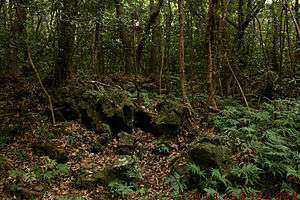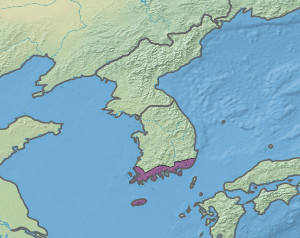Southern Korea evergreen forests
The Southern Korea evergreen forests is a temperate broadleaf and mixed forests ecoregion at the southern end of the Korean Peninsula.
| Southern Korea evergreen forests | |
|---|---|
 | |
 Location map of the Southern Korea evergreen forests | |
| Ecology | |
| Realm | Palearctic |
| Biome | temperate broadleaf and mixed forests |
| Borders | Central Korean deciduous forests |
| Geography | |
| Area | 14,084 km2 (5,438 sq mi) |
| Country | South Korea |
| Conservation | |
| Conservation status | Critical/endangered |
| Protected | 630 km² (4%)[1] |
Setting
The Southern Korea evergreen forests occupy an area of 14,700 square kilometres (5,700 sq mi) in South Korea, at the southern margin of the Korean Peninsula, as well as the Gotjawal Forest on Jeju Island in the East China Sea, 60 km from the Korean coast.[2]
The climate is humid and temperate. Rainfall averages 1000 mm per year, with two-thirds falling between June and September. Winters are drier and mild, with a mean January temperate of 2 °C. There are occasional winter snowfalls, but snow rarely accumulates.[2]
Flora
The natural vegetation is evergreen broadleaf laurel forest, with members of the oak family (Castanopsis cuspidata, Quercus acuta, and Quercus myrsinifolia) and laurel family (Persea thunbergii, Cinnamomum camphora, and others) prominent. Other trees and shrubs include Carpinus laxiflora, Elaeocarpus, Neolitsea, Daphniphyllum macropodum, Ilex integra, Hedera, Eurya japonica, Pittosporum tobira, and Viburnum awabuki.[2]
The Bijarim forest on Jeju is home to dense groves of Bija (Nutmeg or Nutmeg yew, Torreya nucifera)".
Conservation
The forests are mostly gone, replaced by intensive agriculture. Enclaves exist in the Ulsan, Hampyeong, and Naejang-san national monuments, and on Jeju.
A 2017 assessment found that 630 km², or 4%, of the ecoregion is in protected areas. 15% of the unprotected area is still forested.[1]
The ecoregion is home to four national parks, Dadohaehaesang, Hallyeohaesang, and Wolchulsan on the mainland, and Hallasan on Jeju.
References
- Dinerstein, Eric; Olson, David; et al. (June 2017). "An Ecoregion-Based Approach to Protecting Half the Terrestrial Realm". BioScience. 67 (6): 534–545. doi:10.1093/biosci/bix014.CS1 maint: date and year (link) Supplemental material 2 table S1b.
- "Southern Korea evergreen forests". Terrestrial Ecoregions. World Wildlife Fund. Retrieved 8 April 2011.